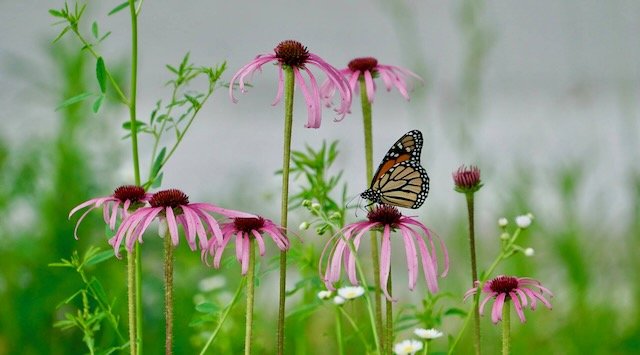October brings Big IMPRESSIONS for Marking Moments
Photos courtesy of the Missouri Dept. of Conservation
Whether I am leading an October hike or in the company of a couple of solid friends, I find myself whispering or saying to myself “Mark this moment”. The month of October sets a stage like no other time. There is simply an abundance of color, animal movement, fragrances, feels, and sounds throughout a fall woodland hike.
The Ozark streams and rivers have a seasonal call out to the naturalist. Most of the partiers of the river scene have left when summer officially ended. A different sort of people now inhabits the riparian zones. They are seeking solitude, fun fish to catch, and to enjoy the background concert of kingfisher’s calls, stonerollers splashing and the tree cricket chorus. A float on Indian Creek in McDonald County places the kayaker simply “in the color”. The creek banks are coated with dogwood burgundy, white oak purple, pawpaw and silver maple yellows, and the multi-hues of sassafras. The canoeist realizes they are in the middle of color when they take notice of the yellow and brown leaves on the stream floor, and the floating sycamore leaves moving on the surface. This is truly a moment to be marked in a naturalist’s memory.
Autumn brings a gathering of wood ducks at the edge of the creek, wild turkey gathered under oaks, and possibly a visible bobcat track along a fencerow. All of this is a humbling reminder that all our wildlife needs proper habitat to grow and prosper. I see many people getting distracted over television commercials on wildlife rehab facilities, and the rescue of a single animal – this is certainly a worthy cause in the example of an endangered species, but far too often, the needs of the wildlife population are overlooked. I have referred to this as Third Grade Ecology over my career. It is the basic considerations of food, water, shelter, and space that every living organism needs every day of the year. October is a prime time to study and take inventory of those components in our parks, private lands, and conservation properties.
While hiking and floating are active ways to take account of October’s treasures, there is a thrilling passive approach that I am going to suggest and to some insist on trying. I hear the conversations from sportsmen all the time stating, “I just love sitting in a tree stand”, or “I find nothing more enjoyable than being in a blind with my grandkids”. They often find themselves part of the wildlife and native plant theatre just as floaters find themselves being a slice of fall’s colorful palate. Therefore, here is my fall enjoyment preparation for you: try taking a lawn chair to a quiet spot on a creek or in the woods. Better yet, research the safety requirements for a tree stand and consider trying this as a new experience if you have not had the opportunity. Bring a camera or binoculars if you wish. Dress for the weather, and if you are outside of hunting seasons try wearing plaids, camouflage, or patterned clothing. Stay away from dressing in white T-shirts, which will “flag” many animals of your location or even possibly give them a warning that you are there. Naturally, full covering of blaze orange should be the attire during any firearms season for legal and safety reasons. Friend and author/fascinating Wildlife photographer Matt Miles describes a bobcat appearing and vanishing like a vapor during a wildlife blind sit, my heart beats fast just thinking of this…bobcats stir me.
No matter how you enjoy this comfortable and colorful month, please share the experience with friends and youth. The Nature Experience has tremendous value for health as well as education and memories, mark these moments as time well invested. I hope to see you on an Ozark trail. – Jeff
Jeff is the advisor for the local MO Master Naturalist chapter and may be reached at jeff.cantrell@mdc.mo.gov





